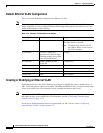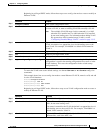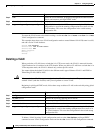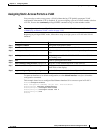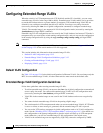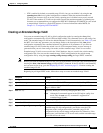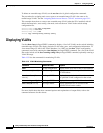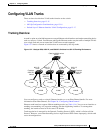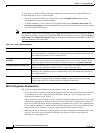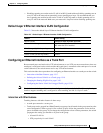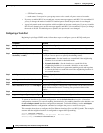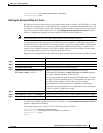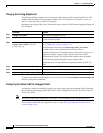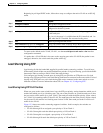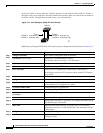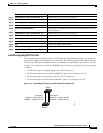
13-16
Catalyst 2950 Desktop Switch Software Configuration Guide
78-11380-05
Chapter 13 Configuring VLANs
Configuring VLAN Trunks
To avoid this, you should configure interfaces connected to devices that do not support DTP to not
forward DTP frames, that is, to turn off DTP.
• If you do not intend to trunk across those links, use the switchport mode access interface
configuration command to disable trunking.
• To enable trunking to a device that does not support DTP, use the switchport mode trunk and
switchport nonegotiate interface configuration commands to cause the interface to become a trunk
but to not generate DTP frames.
Note On GigaStack GBICs, dynamic trunking is only supported when only one port of a GigaStack GBIC is
being used. If trunking is required on a GigaStack GBIC where both ports are in use, use the switchport
mode trunk and switchport nonegotiate interface configuration commands on both GBIC interfaces to
cause the interfaces to become trunks.
802.1Q Configuration Considerations
802.1Q trunks impose these limitations on the trunking strategy for a network:
• In a network of Cisco switches connected through 802.1Q trunks, the switches maintain one instance
of spanning tree for each VLAN allowed on the trunks. Non-Cisco devices might support one
spanning-tree instance for all VLANs.
When you connect a Cisco switch to a non-Cisco device through an 802.1Q trunk, the Cisco switch
combines the spanning-tree instance of the VLAN of the trunk with the spanning-tree instance of
the non-Cisco 802.1Q switch. However, spanning-tree information for each VLAN is maintained by
Cisco switches separated by a cloud of non-Cisco 802.1Q switches. The non-Cisco 802.1Q cloud
separating the Cisco switches is treated as a single trunk link between the switches.
• Make sure the native VLAN for an 802.1Q trunk is the same on both ends of the trunk link. If the
native VLAN on one end of the trunk is different from the native VLAN on the other end,
spanning-tree loops might result.
Table 13-4 Layer 2 Interface Modes
Mode Function
switchport mode access Puts the interface (access port) into permanent nontrunking mode and negotiates to
convert the link into a nontrunk link. The interface becomes a nontrunk interface even if
the neighboring interface is not a trunk interface.
switchport mode dynamic
desirable
Makes the interface actively attempt to convert the link to a trunk link. The interface
becomes a trunk interface if the neighboring interface is set to trunk, desirable, or auto
mode. The default switch-port mode for all Ethernet interfaces is dynamic desirable.
switchport mode dynamic auto Makes the interface able to convert the link to a trunk link. The interface becomes a trunk
interface if the neighboring interface is set to trunk or desirable mode.
switchport mode trunk Puts the interface into permanent trunking mode and negotiates to convert the link into a
trunk link. The interface becomes a trunk interface even if the neighboring interface is
not a trunk interface.
switchport nonegotiate Prevents the interface from generating DTP frames. You can use this command only when
the interface switchport mode is access or trunk. You must manually configure the
neighboring interface as a trunk interface to establish a trunk link.



